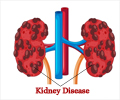Researchers have found a way to reduce kidney injury in patients undergoing a procedure with contrast dye, using quality improvement measures in 8 of the 10 hospitals in the Northern New England Cardiovascular Disease Study Group.

While researchers looked specifically at patients in the cardiology catheterization lab, they believe the methods they developed over a six-year period to prevent kidney injury are generalizable to all of medicine and contrast procedures.
"We believe that using a team-based approach and having teams at different medical centers in northern New England learn from one-another to provide the best care possible for their patients," said Jeremiah Brown of The Dartmouth Institute for Health Policy & Clinical Practice.
Brown and his colleagues found that using a quality improvement design and team coaching, they could reduce kidney injury by 20 percent among all patients and by 30 percent among patients with pre-existing chronic kidney disease.
"Some of the most innovative ideas came from these teams and identified simple solutions to protect patients from kidney injury resulting from the contrast dye exposure," Brown said. "These included getting patients to self-hydrate with water before the procedure (8 glasses of water before and after the procedure), allow patients to drink fluids up to two hours before the procedure (whereas before they were "NPO" for up to 12 hours and came to the hospital dehydrated), training the doctors to use less contrast in the procedure (which is good for the patient and saves the hospital money), and creating stops in the system to delay a procedure if that patient had not received enough oral or intravenous fluids before the case (rather, they would delay the case until the patient received adequate fluids)."
Using a simple team-based approach, Brown and colleagues from 10 medical centers in northern New England prevented kidney injury in 1 out of every 5 patients undergoing a cardiac catheterization procedure.
Advertisement
Source-Eurekalert















